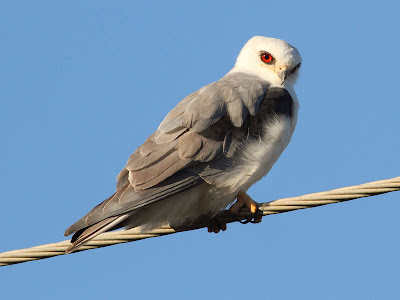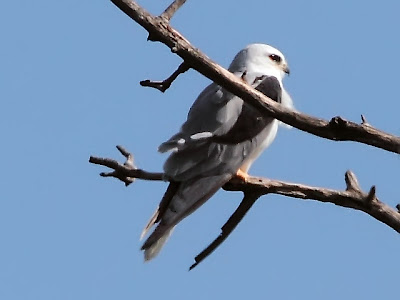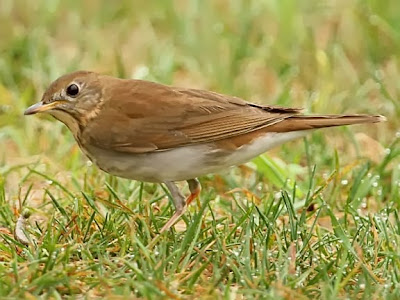The yellow-rumped warbler is a mid-sized warbler found in North and Central America. They get their name from the bright yellow rump patch that is located at the base of the tail. This patch has also the reason for their nickname, "Butter Butt". They also have yellow on their heads and yellow patches on their sides. Males are usually a striking contrast of black and white, while females tend to be more brown.
Yellow-rumps are expert foragers. They primarily eat insects which they glean from trees, males typically foraging higher in the trees then females. They will also catch insects on the wing, flying out from the branches that they have been gleaning from like a flycatcher. When there are no insects around yellow-rums will eat seeds and berries. They are the only species of warbler that can digest bayberries and wax myrtles. Because of this they are able to winter further north then other warbler species. Which is why they are usually the first warbler species that we see in spring and the last to leave in the fall.
There are four different variations of yellow-rumped warblers. Two of the forms are non-migratory. They are the Black-fronted, from north western Mexico, and the Goldman's from Guatemala. The other two forms are migratory. They are the Myrtle (top 2 photos), which breed in eastern Canada and parts of the northern United States, and the Audubon (last photo) Which breed in western Canada, Alaska, the Pacific Coast, and Rocky Mountains. Both forms winter in the southern United States, Mexico, Central America and the Caribbean.
Tuesday, December 31, 2013
Wednesday, December 25, 2013
Tuesday, December 17, 2013
White-tailed Kite
The white-tailed kite is a medium sized raptor that is found along the west coast of the United States, southern Florida, Mexico, Central and South America. They were at one time, grouped together with the European black-winged kite as a single species called the black-shouldered kite. However because of differences in size and behavior the species was divided into the white-tailed kite, in the Americas, The black-winged kite, in Europe and Africa, and the black-shouldered kite, in Australia.
The first white-tailed kites that we spotted, and photographed, where at the Elkhorn Slough National Estuarine Research Reserve near Monterey Bay in California. White-tailed kites were almost extricated from California by 1940 due to hunting and egg collecting. Preservation laws, like the Migratory Bird Act, gave protection to native species of birds and their eggs. This includes the white-tailed kite which, I am happy to say, are now common again in many parts of California. These first two pictures where taken in southern Texas where white-tailed kites can also be found.
Their preferred habitat is open country, such as grass savannas, marshes, desert grasslands and farm fields, where they hunt primarily small rodents. In 2012 while I was out photographing at Crex Meadows in Wisconsin I was surprised to spot a perched white-tailed kite. Now Crex meadows is perfect habitat for white-tailed kites, however it is way out of their normal range. This was only the third time on record that a white-tailed kite had been observed in Wisconsin. Now the winter of 2011 -2012 was unseasonably warm and lacking in snow which might explain why this bird was in Wisconsin. The have been known to venture far from their range and have been spotted as far away as New England. It was still exciting though and people came from all around to get a glimpse, especially since the last sighting in Wisconsin was over 10 years before.Tuesday, December 10, 2013
Veery
The very is a member of the thrush family that breeds in the swampy forests of the northern United States and southern Canada. They are much less common then the American thrush, otherwise known as the American robin. They are a spotted thrush but have less spots then other species of spotted thrush. As an insect eater they do not hang around on their breeding grounds during the winter. Instead they migrate down to the northern and central portions of South America, primarily Brazil. Like most passerines they migrate at night and can travel distances up to 160 miles per night.
Tuesday, December 3, 2013
Unfortunate!
As an environmentalist I am happy that small steps have been made to transition our energy needs to cleaner sustainable sources. New sources like wind, solar and wave technologies lessen our dependency on sources like coal, oil, natural gas, and nuclear. These older technologies pollute the environment and can be very dangerous.
Unfortunately good intentions can sometimes have bad side effects. That has been the case with wind energy. A study by the Us Fish and Wildlife Service reports that at least 85 golden and bald eagles were killed at wind farms between 1997 and 2012. That may not sound like a huge number over 5 years, however the study relied mainly on volunteered reports of fatalities by the wind energy companies. So it is possible the number may be much higher. The study also did not include all US wind farms. The Altamont Pass Wind Resource Area in California was not included in the study. It is located in an area with a high population of golden eagles and may be responsible for as many deaths as reported in the study every year.
Most of the concern is about eagles but other types of raptors also collide with windmills. Raptors typically watch the ground when they fly because they are looking for food. By the time they notice the structure it is too late as the blades which can be spinning in excess of 150 mph create wind currents that can suck the birds in. Most of the deaths happen at older facilities. While the UFAWS report has sparked awareness on this issue from concerned citizens a 1 million dollar fine that was recently levied against a wind energy company in Montana has gotten the attention of the wind industry. Some Wind energy companies now hire people to do impact studies before building new farms. Unfortunately the best location for wind farms are often great habitat for eagles. Other technologies, such as radar that can turn of turbines when it detects an eagle in the area, are also helping us to create a cleaner environment while minimizing our impact on eagles and other birds of prey.
Labels:
ABC Wednesday,
bald eagle,
golden eagle,
Wild Bird Wednesday
Subscribe to:
Comments (Atom)




















